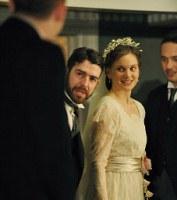A Woman Killed With Kindness
Written by Shakespeare's contemporary, Thomas Heywood, this play was first performed in 1603. Heywood was a prolific writer who managed to pen more than 200 plays, of which 'A Woman Killed With Kindness' is generally considered to be his best.
The play is not about royalty, heroes or mythological characters, but ordinary people. Some of the main characters do seem to be quite well-off, but they are ordinary in the sense that we witness the trials of their daily lives and see their emotions on display. This is one of the most famous play of the genre known as 'domestic tragedy' which first appeared during the Renaissance.
The tail-end of a wedding starts off the proceedings. John Frankford has just married Anne and two of his guests, Sir Francis Acton (Anne's brother) and Sir Charles Mountford place a wager. The next day they argue over the bet, and Sir Charles subsequently kills one of Acton's servants. Charles is thrown into prison leaving his hermit-like sister, Susan, to fend for herself, and the contents of their country home are sold to extricate him, but then he has to borrow more money to survive. While the Mountford's wrestle with their dire financial situation, back at the Frankford's house John asks a friend, Wendoll, to stay with them and the guest promptly falls in love with Anne. When John is eventually told about the adultery by his servant, Nick, he gets his revenge not by violence, but by giving Anne a place to live and allowing her to take all her possessions, but not her children.
The action alternates between the fading elegance of the Mountford's home and the more prosperous and comfortable one that the Frankfords inhabit. The two homes sit side-by-side on a massive, fully-enclosed and impressive set designed by Lizzie Clachan and Vicki Mortimer.
Katie Mitchell's directorial style shines through in the choice of music and sound effects, as well as the choreographed interludes between the main scenes. The play is brought into the twentieth century by setting it immediately after the end of the First World War, in the spring of 1919. Just why this particular period was chosen for the setting is unclear, though the position of women in society might lead to an explanation. In fact, this is a play about women in both society and the home. Susan and Anne have much in common including the fact that they are both used, and to some extent abused, by men.
Heywood's play is well-plotted and the story is compelling enough to make 2 hours (without an interval) speed by, even if the ending is rather melodramatic. Katie Mitchell's production is stimulating, thoughtful, and meticulously orchestrated. But there are times when it is hard to hear what some of the actors are saying which rather spoils what is otherwise a fascinating piece.
"A robustly intelligent re-reading of a tricky play."
Fiona Mountford for The Evening Standard
"There is a constantly mirrored imagery in Mitchell's exquisitely textured production...The production is alive to the rhythms of everyday life."
Lyn Gardner for The Guardian
"A taut and fairly gripping account of a play driven by its duality."
Susan Elkin for The Stage
"I find it hard to share Mitchell's enthusiasm for such a cold and curiously unrewarding play, and staging this two-hour piece without an interval feels like an act of cruelty rather than kindness."
Charles Spencer for The Daily Telegraph
External links to full reviews from popular press
The Guardian - Telegraph -
Originally published on
